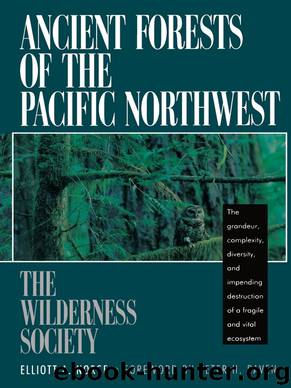Ancient Forests of the Pacific Northwest by Elliott A. Norse

Author:Elliott A. Norse [Norse, Elliott A.]
Language: eng
Format: epub
ISBN: 9781610912488
Publisher: Island Press
Published: 2013-03-27T04:00:00+00:00
1. In many ways, ecosystem fragments are islands. Insularity means being surrounded by any barrier. To a species that does equally well in forests and grasslands, a forested patch in a sea of grass is not an island. But to one that cannot disperse across grassland, a patch of forest is as much an island as if it were surrounded by water.
2. Some species seem to colonize new fragments across unsuitable habitats poorly, if at all. Sometimes colonization is rare or nonexistent, so that more species occur in larger patches solely because they have lower extinction rates. This might seem surprising; it seems logical that organisms would have mechanisms allowing them to traverse unsuitable habitats. But as Mike Soule and coauthors (1988) found, even birds can have real problems dispersing among nearby habitat fragments.
3. Smaller islands retain fewer species than larger islands and for a shorter time. Species vary enormously in their need for resources such as food; a mouse’s home range is thousands of times smaller than a bear’s. Two groups—species that feed on widely dispersed or rare resources and species that need large amounts of space—cannot maintain breeding populations within small habitat fragments.
However, a fragment may not have a species even if it is large enough to support a small breeding population. Small populations are more vulnerable to extinction from random factors: adverse environmental conditions (e.g., droughts), population fluctuations, and fixation of deleterious genes and loss of beneficial ones. As a result, small fragments have higher extinction rates than large ones. But if anything, colonization rates are lower. If a species that vanishes from a small fragment cannot recolonize it, the number of species in that fragment declines.
Moreover, some species suffer when their ecosystems are fragmented because conditions change in ways that are anything but random. Compared with clearcuts, forests are cooler in hot weather, moister and less windy. Further, forest interiors are safe havens from species that live in edge habitats. There is evidence suggesting that in forest interiors, songbirds suffer less brood parasitism by brown-headed cowbirds and spotted owls suffer less predation by great horned owls than at forest edges. But the smaller the fragment, the larger the portion that functions as edge. The influence of external forces extends far enough that many fragments in today’s landscapes are, in effect, all edge. For all these reasons, a fragment that now supports species from the original forest will not necessarily do so in the future.
4. Heterogeneous islands retain more species than homogeneous ones. The more different environmental features in a fragment, the more species it can retain. For example, a forest fragment having a permanent stream will retain more species than one without; a fragment having both moister (e.g., northeast) and drier (e.g., southwest) aspects will retain more than one with uniform exposure.
5. The effect of island size differs among organisms. Although all groups of organisms are more diverse on larger islands than on smaller ones, the effect of island size affects groups differently. For example (Figure 6.
Download
This site does not store any files on its server. We only index and link to content provided by other sites. Please contact the content providers to delete copyright contents if any and email us, we'll remove relevant links or contents immediately.
| Automotive | Engineering |
| Transportation |
Whiskies Galore by Ian Buxton(41530)
Introduction to Aircraft Design (Cambridge Aerospace Series) by John P. Fielding(32888)
Small Unmanned Fixed-wing Aircraft Design by Andrew J. Keane Andras Sobester James P. Scanlan & András Sóbester & James P. Scanlan(32573)
Craft Beer for the Homebrewer by Michael Agnew(17933)
Turbulence by E. J. Noyes(7700)
The Complete Stick Figure Physics Tutorials by Allen Sarah(7141)
Kaplan MCAT General Chemistry Review by Kaplan(6595)
The Thirst by Nesbo Jo(6437)
Bad Blood by John Carreyrou(6275)
Modelling of Convective Heat and Mass Transfer in Rotating Flows by Igor V. Shevchuk(6223)
Learning SQL by Alan Beaulieu(6035)
Weapons of Math Destruction by Cathy O'Neil(5829)
Man-made Catastrophes and Risk Information Concealment by Dmitry Chernov & Didier Sornette(5649)
Digital Minimalism by Cal Newport;(5389)
Life 3.0: Being Human in the Age of Artificial Intelligence by Tegmark Max(5184)
iGen by Jean M. Twenge(5162)
Secrets of Antigravity Propulsion: Tesla, UFOs, and Classified Aerospace Technology by Ph.D. Paul A. Laviolette(4992)
Design of Trajectory Optimization Approach for Space Maneuver Vehicle Skip Entry Problems by Runqi Chai & Al Savvaris & Antonios Tsourdos & Senchun Chai(4840)
Electronic Devices & Circuits by Jacob Millman & Christos C. Halkias(4748)
